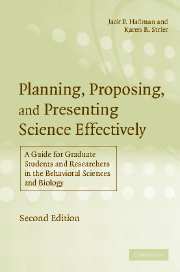 Planning, Proposing, and Presenting Science Effectively
Planning, Proposing, and Presenting Science Effectively Preface
Published online by Cambridge University Press: 01 September 2010
Summary
Training in the biological sciences, and indeed in most sciences, appropriately emphasizes mastery of techniques and theory – essential elements of any original research endeavor. The less glamorous steps to successful research are often neglected in the formal training programs of scientists – such as how to plan a study adequately, secure research funds effectively, present results (written and oral) clearly and interestingly, and present qualifications in a résumé. This book is a map to those activities, with examples drawn primarily from the authors' discipline of behavioral ecology. In the first edition, we integrated our own experiences with the most frequent problems encountered by our students to produce what we hoped would be a helpful, concise guide to the more practical aspects of scientific research. In this second edition, we have updated these tips to accompany the changes that advances in computer technology and the Internet have brought to the practical sides of submitting research grants and manuscripts and presenting research in talks and posters. We have also deleted one of our original appendixes, which provided addresses for funding agencies, because these are now readily available on the Web, and have replaced it with an appendix on ethics considerations. The basics of planning scientific research remain the same, however.
Our concern is with widely applicable skills. If you want to know details – such as what research questions are currently considered “hot” in your field, what organizations are currently offering monies for what kinds of research, what laboratory and field techniques are state-of-the-art, or how to use modern computer-intensive statistical applications properly – you must seek specific sources appropriate to your needs.
Information
- Type
- Chapter
- Information
- Planning, Proposing, and Presenting Science EffectivelyA Guide for Graduate Students and Researchers in the Behavioral Sciences and Biology, pp. vii - xPublisher: Cambridge University PressPrint publication year: 2006